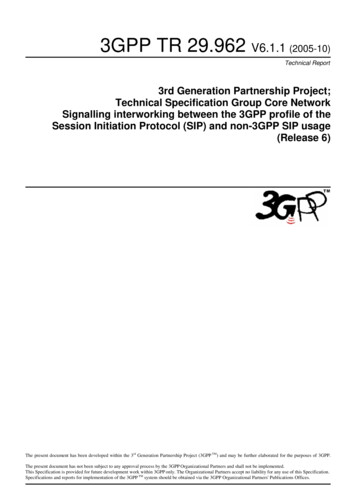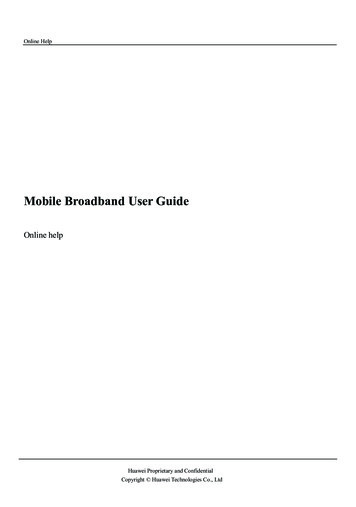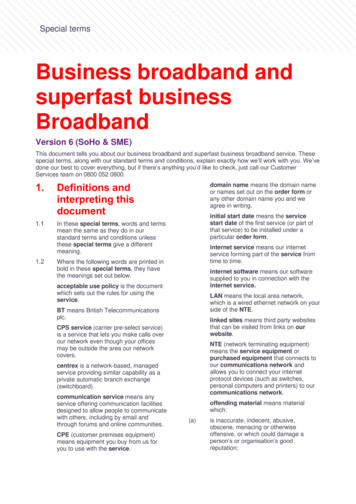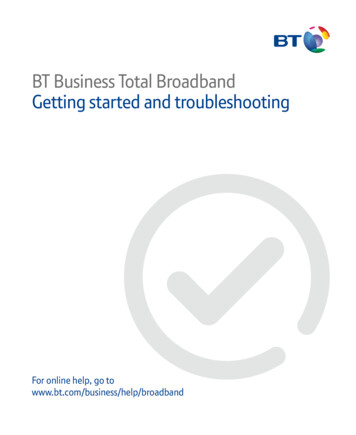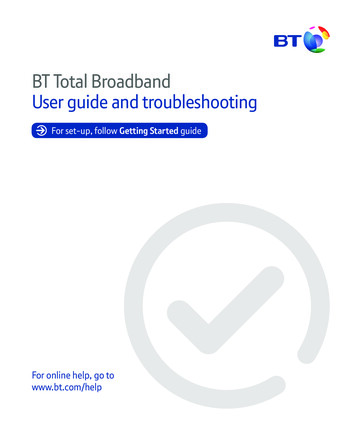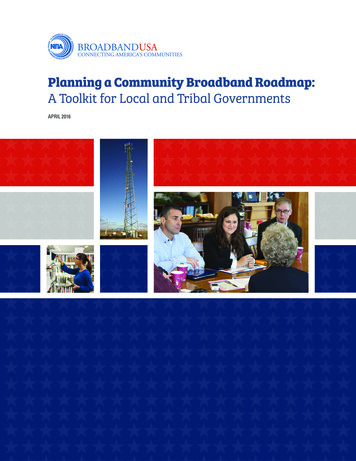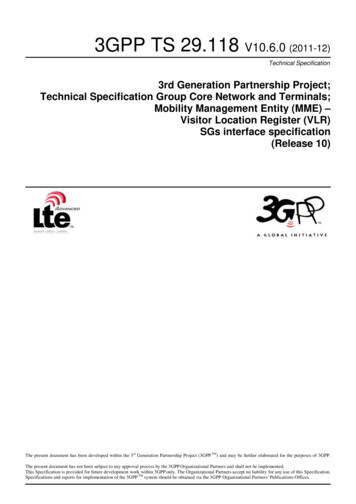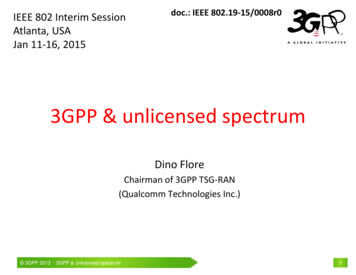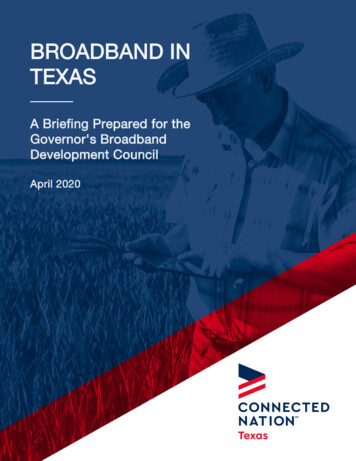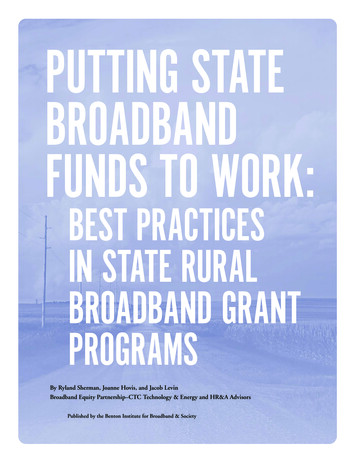
Transcription
TABLE OF CONTENTSTABLE OF CONTENTS . 11INTRODUCTION . 42GLOBAL MARKET TRENDS, MILESTONES AND STANDARDIZATION . 62.1Mobile Data Growth Forecasts and Trends . 92.2Wireless Data Revenue. 102.3Mobile Broadband Devices . 142.4Mobile Broadband Applications . 182.5Mobile Broadband Deployments and Spectrum . 222.6Milestones From Release 99 to Release 12: UMTS/Evolved HSPA (HSPA ) and LTE/EPC/LTE-Advanced 252.6.1HSPA and HSPA Progress Timeline . 252.6.2LTE and LTE-Advanced Progress Timeline . 282.733GPP Release 12 Standardization . 33STATUS OF 3GPP RELEASE 11: LTE-ADVANCED AND HSPA ENHANCEMENTS . 353.1LTE-Advanced Enhancements . 353.1.1Coordinated Multi-Point (CoMP) Transmission and Reception . 353.1.2Carrier Aggregation (CA) Enhancements . 383.1.3Further Heterogeneous Networks Enhancements (FeICIC) . 423.1.4Enhanced Physical Downlink Physical Control Channel (EPDCCH) . 433.1.5Evolved Multimedia Broadcast Multicast Service (eMBMS) Service Continuity and Location Information 453.1.6Further Self-Optimizing Network (SON) Enhancements . 453.1.7Signaling and Procedure for Interference Avoidance for In-Device Coexistence . 513.1.8Machine Type Communications (MTC). 523.1.9Further Home NodeB and eNodeB Enhancements . 533.2HSPA Enhancements . 553.2.1Downlink (DL) Enhancements . 553.2.2Uplink (UL) Enhancements . 593.2.3Cell FACH Improvements . 603.2.4Machine Type Communications (MTC). 614G Americas / 4G Mobile Broadband Evolution: 3GPP Release 11 & Release 12 and Beyond / February 20141
3.3Network and Services Related Enhancements . 613.3.1Machine Type Communications (MTC). 613.3.2Network Provided Location Information for IMS (Netloc) . 673.3.3Single Radio Voice Call Continuity (SRVCC). 693.3.4QoS Control Based on Subscriber Spending Limits (QoS SSL) . 723.3.5Multimedia Emergency Services (MMES) . 753.3.6Interworking with Wi-Fi Enhancements . 763.3.7Universal Integrated Circuit Card (UICC) Enhancements . 763.3.8UICC Inside Handsets Enabling Femtocell . 773.3.9Lawful Interception Enhancements. 783.44Release Independent Features . 78PROGRESS OF 3GPP RELEASE 12: LTE-ADVANCED AND HSPA ENHANCEMENTS . 804.1LTE-Advanced Enhancements . 804.1.1Downlink (DL) Enhancements . 814.1.2Small Cell Enhancements . 834.1.3Femto Enhancements . 894.1.4Machine Type Communications (MTC). 914.1.5Proximity Services (ProSe) . 934.1.6User Equipment (UE) Enhancements . 944.1.7Self-Optimizing Network (SON) Enhancements . 954.1.8Heterogeneous Networks Mobility . 954.1.9Multimedia Broadcast Multicast Service (MBMS) Enhancements . 964.1.10Local Internet Protocol Access/Selected Internet Protocol Traffic Offload (LIPA/SIPTO) Enhancements . 984.1.11Enhanced IMT-Advanced (eIMTA) . 994.1.12Frequency Division Duplex-Time Division Duplex (FDD-TDD) Carrier Aggregation. 1014.2HSPA Enhancements . 1024.2.1Universal Mobile Telecommunication System (UMTS) Heterogeneous Networks . 1024.2.2Scalable UMTS FDD Bandwidth . 1084.2.3Further EUL Enhancements . 1124G Americas / 4G Mobile Broadband Evolution: 3GPP Release 11 & Release 12 and Beyond / February 20142
4.2.4HNB Emergency Warning Area for Universal Terrestrial Radio Access Network (UTRAN) . 1164.2.5Further Enhancements for HNB Mobility . 1164.2.6HNB Positioning for UTRA . 1174.2.7Machine Type Communications (MTC). 1174.2.8Dedicated Channel (DCH) Enhancements . 1184.34.3.1Machine Type Communications (MTC). 1204.3.2Public Safety . 1224.3.3Wi-Fi Integration . 1294.3.4Core Network Overload . 1354.3.5Web Real-Time Communication (WebRTC) . 1404.3.6Further Network Energy Saving . 1414.3.7Multimedia . 1414.3.8Policy And Charging Control (PCC) Framework Enhancements . 1464.45Network And Services Related Enhancements . 120Release Independent Features . 149CONCLUSION . 152APPENDIX A: RELEASE INDEPENDENT FREQUENCY BANDS . 153APPENDIX B: GLOBAL DEPLOYMENTS STATUS – HSPA/HSPA /LTE/LTE-ADVANCED . 159APPENDIX C: MEMBER PROGRESS . 189APPENDIX D: ACRONYM LIST. 201ACKNOWLEDGMENTS . 2104G Americas / 4G Mobile Broadband Evolution: 3GPP Release 11 & Release 12 and Beyond / February 20143
1INTRODUCTIONContemporary drivers’ license test question: “What do you do at a red light?” Answer: “Check my email.” (Not the correctanswer, unfortunately!)While this is fictional, the fact that it rings true to many of us testifies to the role of mobility in our lives. Of the 6.8 billionmobile subscriptions in the world today, 2.1 billion are mobile broadband, which is three times the number of fixedbroadband accounts. Moreover, almost every edition of 4G Americas’ white papers on 3GPP standards (now ten years ofhistory) started by stating in some form that the number of cell phone accounts are expected to “soon” exceed the numberof human beings on the planet—however, this is no longer the case since “soon” is now. According to the InternationalTelecommunications Union (ITU), the number of mobile subscriptions will rise to 7.3 billion in 2014, compared to theglobal population of 7 billion.The resource of mobile communications could almost be compared to other invaluable resources like potable water andtillable soil, as it advances human and economic development from providing basic access to health information to makingcash payments, spurring job creation and stimulating citizen involvement in democratic processes. However, there aredeficiencies. Two-thirds of the world population still has no internet access. While 75 percent of households indeveloping countries have television, only 20 percent are connected to the web. However, mobile use is a globalphenomenon; there are more than one hundred countries throughout the world, where the number of cell phones exceedsthe countries’ populations.In the words of ITU Secretary-General, Dr. Hamadoun I. Touré, “ looking at the trends, I am personally confident thatover the next decade or so we will see every household, village, school, and hospital fully connected to the Internet, andthat Internet will be affordable.”1At the grassroots level, this confidence may be attributed to the careful science of technology standards developed by the3rd Generation Partnership Project (3GPP). The standards work by 3GPP, the foundation of the world’s mobilebroadband infrastructure, is delivering international communications technologies to the masses via the Global System forMobile Communications (GSM) family of technologies, which is interchangeably called the 3GPP family of technologies asthey are based on the evolution of standards developed for GSM, Enhanced Data Rates for GSM Evolution (EDGE),Universal Mobile Telecommunication System (UMTS), High Speed Packet Access (HSPA), HSPA , Long Term Evolution(LTE) and LTE-Advanced.It may be helpful to consider the historical development of the 3GPP UMTS standards. Beginning with the inception ofUMTS in 1995, UMTS was first standardized by the European Telecommunications Standards Institute (ETSI) in January1998 in Release 99 (Rel-99). This first release of the Third Generation (3G) specifications was essentially a consolidationof the underlying GSM specifications and the development of the new Universal Terrestrial Radio Access Network(UTRAN). The foundations were laid for future high-speed traffic transfer in both circuit-switched and packet-switchedmodes. The first commercial launch (Freedom of Mobile Multimedia Access (FOMA), a derivation of UMTS) was byJapan's NTT DoCoMo in 2001.In April 2001, a follow up release to Rel-99 was standardized in 3GPP, termed Release 4 (Rel-4), which provided minorimprovements of the UMTS transport, radio interface and architecture.The rapid growth of UMTS led to a focus on its next significant evolutionary phase, namely Release 5 (Rel-5) which wasfrozen in June 2002. 3GPP Rel-5 – first deployed in 2005 – had many important enhancements that were easy upgradesto the initially deployed Rel-99 UMTS networks. Rel-5 provided wireless operators with the improvements needed to offercustomers higher-speed wireless data services with vastly improved spectral efficiencies through the High SpeedDownlink Packet Access (HSDPA) feature. In addition to HSDPA, Rel-5 introduced the Internet Protocol Multimedia1 State of the Union Address, ITU Council, 4 July 2012, Geneva, Switzerland.4G Americas / 4G Mobile Broadband Evolution: 3GPP Release 11 & Release 12 and Beyond / February 20144
Subsystem (IMS) architecture that promised to greatly enhance the end-user experience for integrated multimediaapplications and offer mobile operators a more efficient means for offering such services.UMTS Rel-5 also introduced the IP UTRAN concept to recognize transport network efficiencies and reduce transportnetwork costs.Release 6 (Rel-6), published in March 2005, defined features such as the uplink Enhanced Dedicated Channel (E-DCH),improved minimum performance specifications for support of advanced receivers at the terminal and support of multicastand broadcast services through the Multimedia Broadcast/Multicast Services (MBMS) feature. E-DCH was one of the keyRel-6 features that offered significantly higher data capacity and data user speeds on the uplink compared to Rel-99UMTS through the use of a scheduled uplink with shorter Transmission Time Intervals (TTIs as low as 2 ms) and theaddition of Hybrid Automatic Retransmission Request (HARQ) processing. Through E-DCH, operators benefitted from atechnology that provided improved end-user experience for uplink intensive applications such as email with attachmenttransfers or the sending of video (e.g. videophone or sending pictures). In addition to E-DCH, UMTS Rel-6 introducedimproved minimum performance specifications for the support of advanced receivers. Examples of advanced receiverstructures include mobile receive diversity, which improves downlink spectral efficiency by up to 50 percent, andequalization, which significantly improves downlink performance, particularly at very high data speeds. UMTS Rel-6 alsointroduced the MBMS feature for support of broadcast/multicast services. MBMS more efficiently supported serviceswhere specific content is intended for a large number of users such as streaming audio or video broadcast.Release 7 (Rel-7) moved beyond HSPA in its evolution to HSPA and also the standardization of Evolved EDGE; the finalStage 3 was published in March 2007. The evolution to 3GPP Rel-7 improved support and performance for real-timeconversational and interactive services such as Push-to-Talk Over Cellular (PoC), picture and video sharing, and Voiceand Video over Internet Protocol (VoIP) through the introduction of features like Multiple-Input Multiple-Output (MIMO),Continuous Packet Connectivity (CPC) and Higher Order Modulations (HOMs). These Rel-7 enhancements are calledEvolved HSPA or HSPA . Since the HSPA enhancements are fully backwards compatible with Rel-99/Rel-5/Rel-6, theevolution to HSPA was made smooth and simple for operators.Release 8 (Rel-8) specifications, frozen in December 2008 and published in March 2009, included enhancements to theEvolved HSPA (HSPA ) technology, as well as the introduction of the Evolved Packet System (EPS) which consists of aflat IP-based all-packet core System Architecture Evolution/Evolved Packet Core (SAE/EPC) coupled with a newOrthogonal Frequency Division Multiplexing Access (OFDMA)-based Radio Access Network (RAN) (Evolved UniversalTerrestrial Radio Access Network) (E-UTRAN/LTE)).Note: The complete packet system consisting of the E-UTRAN and the EPC is called the EPS. In this paper, the termsLTE and E-UTRAN will both be used to refer to the evolved air interface and radio access network based on OFDMA,while the terms SAE and EPC will both be used to refer to the evolved flatter-IP core network. Additionally, at times EPSwill be used when referring to the overall system architecture.While the work towards completion and publication of Rel-8 was ongoing, planning for content in Release 9 (Rel-9) andRelease 10 (Rel-10) began. In addition to further enhancements to HSPA , Rel-9 was focused on LTE/EPCenhancements. Due to the aggressive schedule for Rel-8, it was necessary to limit the LTE/EPC content of Rel-8 toessential features (namely the functions and procedures to support LTE/EPC access and interoperation with legacy 3GPPand 3GPP2 radio accesses) plus a handful of high priority features (such as Single Radio Voice Call Continuity (SRVCC),generic support for non-3GPP accesses, local breakout and Circuit Switched (CS) fallback). The aggressive schedule forRel-8 was driven by the desire for fast time-to-market LTE solutions without compromising the most critical featurecontent. 3GPP targeted a Rel-9 specification that would quickly follow Rel-8 to enhance the initial Rel-8 LTE/EPCspecification.At the same time that these Rel-9 enhancements were being developed, 3GPP recognized the need to develop a solutionand specification to be submitted to the ITU for meeting the IMT-Advanced requirements. Therefore, in parallel with Rel-9work, 3GPP worked on a study item called LTE-Advanced, which defined the bulk of the content for Rel-10, to includesignificant new technology enhancements to LTE/EPC for meeting the very aggressive IMT-Advanced requirements. On4G Americas / 4G Mobile Broadband Evolution: 3GPP Release 11 & Release 12 and Beyond / February 20145
October 7, 2009, 3GPP proposed LTE-Advanced at the ITU Geneva conference as a candidate technology for IMTAdvanced and one year later in October 2010, LTE-Advanced was approved by ITU-Radiotelecommunication Sector(ITU-R) as having met all the requirements for IMT-Advanced (final ratification by the ITU occurred in November 2010).Rel-11 built on that work and further refined topics were Coordinated Multi-Point Transmission and Reception (CoMP),Carrier Aggregation (CA), Heterogeneous Network (HetNet) and Self-Optimizing or Self-Organizing Network (SON)Tracking these standards, 3G Americas, and now 4G Americas, has annually published a white paper to provide the mostcurrent “understanding” of the 3GPP standards work, beginning in 2003 with a focus on Release 1999 (Rel-99) throughOctober 2012 and the publication of 4G Mobile Broadband Evolution: Release 10, Release 11 and Beyond - HSPA,SAE/LTE and LTE-Advanced. The latter paper provided detailed discussions of Release 11 enhancements to LTE/EPC(called LTE-Advanced). This paper, as a follow-up, is focused on updating LTE-Advanced and HSPA in Release 11(Rel-11) items as the standardization was finalized at the end of 2012, and provides a detailed view of the ongoingRelease 12 (Rel-12) features that are nearing finalization. Rel-12 continues to build on LTE-Advanced and HSPA withfurther focus on downlink enhancements, needed strengthening to various small cell features, expanding carrieraggregation, enabling Machine Type Communications (MTC) and Wi-Fi integration, as well as looking at system capacityand stability. It has been prepared by a working group of 4G Americas' member companies and the material representsthe combined efforts of many leading experts from 4G Americas’ membership.2GLOBAL MARKET TRENDS, MILESTONES AND STANDARDIZATIONAlmost 50 percent of all people worldwide are now covered by a 3G network, according to the InternationalTelecommunications Union (ITU). Mobile broadband connections over 3G (HSPA and Code Division Multiple Access(CDMA) Evolution Data Optimized (EV-DO)) and LTE networks are growing at an average annual rate of 40 percent, witha total of 2.1 billion mobile-broadband subscriptions and a global penetration rate of almost 30 percent. 2Mobile broadband enables advanced data services, and data traffic now significantly outweighs voice traffic; it more thandoubled in 2011 and again in 2012, and could nearly double again in 2013. 3In its annual Visual Networking Index Forecast 2012-2017, Cisco Systems reported that global mobile data traffic willincrease 113 percent year-over-year between 2012 and 2017. The report also predicts that mobile data traffic will grow ata compound annual growth rate of 66 percent from 2012 to 2017, which is equivalent to the consumption of 11.2 Exabytesper month by the end of 2017.42 ITU, Measuring the Information Society report, 7 October 2013.3 Ericsson Mobility Report, Interim Update. August 2013.4 Cisco: Visual Networking Index: Global Mobile Data Traffic Forecast Update, 2012-2017, February 2013.4G Americas / 4G Mobile Broadband Evolution: 3GPP Release 11 & Release 12 and Beyond / February 20146
5Figure 2.1. Global Mobile Data Traffic 2012 to 2017.The exponential increase in data consumption will be driven by powerful smartphones and tablets capable of running onaverage speeds of 5.244 Mbps on LTE and Wi-Fi networks. According to Cisco, in 2017, 4G will be 10 percent ofconnections, but 45 percent of total traffic, and a 4G connection will generate 8 times more traffic on average than a non4G connection. Mobile network connection speeds will increase 7-fold by 2017.Ericsson’s November 2013 Mobility Report revealed that mobile subscriptions are expected to reach 9.3 billion by 2019,and more than 60 percent of these (5.6 billion) will be for smartphones. To support the smartphone user experience,Wideband Code Division Multiple Access (WCDMA)/HSPA networks are predicted to cover 90 percent of the world'spopulation by 2019. Moreover, almost two-thirds (65 percent) of the world's population will be covered by 4G/LTEnetworks.6Mobile network connection speeds more than doubled in 2012. Globally the average mobile network downstream speedin 2012 was 526 kilobits per second (kbps) up from 248 kbps in 2011. The average mobile network connection speed willexceed 3.9 Mbps in 2017. However, average speeds for smartphones and tablets are considerably higher; 2,064 kbps forsmartphones and 3,683 kbps for tablets in 2012.7The decline of global Second Generation (2G) GSM connections began in 2013 and the trending growth of 3G and FourthGeneration (4G) mobile broadband HSPA and LTE technologies continues unabated. Of the estimated 6.8 billion totalwireless subscriptions as of the end of 2013, there were 1.6 billion HSPA and LTE mobile broadband subscriptions. Thisnumber is expected to grow to 5.6 billion in another five years.85 Cisco Visual Networking Index: Global Mobile Data Traffic Forecast Update, Cisco, February 2013.6 Ericsson’s Mobility Report. 11 November 2013.7 Cisco Visual Networking Index: Global Mobile Data Traffic Forecast Update, 2012-2017, February 2013.8 Informa Telecoms & Media, WCIS Estimates, December 20134G Americas / 4G Mobile Broadband Evolution: 3GPP Release 11 & Release 12 and Beyond / February 20147
Figure 2.2. Global Mobile Technology Shares 4Q 2013 – Forecast 4Q 2018.9While GSM represents 66 percent of the global market in 2013, this will decline to 22 percent worldwide GSM marketshare in five years. HSPA will more than double and LTE will grow 8-fold. The shift from 2G is evident; some serviceproviders (e.g., AT&T) have announced sunsetting their 2G networks by 2017 to allow their customers advanced notice toproperly plan in areas such as Machine-to-Machine (M2M) communications and other connected devices. The need forservice providers to sunset their networks weighs heavily on their available spectrum assets, refarming their spectrum andgetting the best efficiencies by using more advanced 4G technology in those limited spectral resources.Ericsson reported that global mobile broadband subscriptions grew by around 40 percent year-on-year at the third quarter,with around 150 million additions. LTE is growing rapidly and reached 150 million subscriptions, with around 25 millionadditions in Q3 2013 alone. WCDMA/HSPA had the highest net additions at around 80 million. Almost all of these 3G/4Gsubscriptions have access to GSM/EDGE as a fallback. The number of GSM/EDGE-only subscriptions did not increase.10Ericsson expects LTE subscriptions to exceed 1 billion in 2017, driven by more capable devices and demand for dataintensive services such as video.11Global mobile broadband subscriptions passed 2 billion in 2013 and are predicted to grow 4 times by 2019, reaching 8billion. LTE is being deployed and built-out in all regions and will reach around 2.6 billion subscriptions in 2019. 12In North America, LTE will represent the majority of subscriptions in the region in 2016, growing to around 85 percent in2019. GSM/EDGE-only subscriptions will progressively decline. This fast growth in LTE subscriptions is driven by strongcompetition and consumer demand, following CDMA operators’ early decisions to migrate to LTE. 139 WCIS , 4Q 2013 Estimates & Forecast. Informa Telecoms & Media.10 Ericsson Mobility Report. 11 November 2013.11 Ericsson Mobility Report. June 2013.12 Ericsson’s Mobility Report. 11 November 2013.13 Ibid.4G Americas / 4G Mobile Broadband Evolution: 3GPP Release 11 & Release 12 and Beyond / February 20148
In November 2013, AT&T reported that traffic on their HSPA subscription growth had peaked as more and morecustomers were using LTE devices. AT&T reported that at the end of the third quarter, 42 percent of its postpaidsmartphone customers were using an LTE device.14Latin America had a large GSM/EDGE subscriber base of about 70 percent in 2013. The strong growth in subscriptions inthis region will be driven by economic development and consumer demand. In 2019, WCDMA/HSPA will be the dominanttechnology with about 70 percent market share and LTE expected to have a slightly higher percentage of the market thanGSM/EDGE-only subscriptions. 15In this section, the global market trends of wireless data are demonstrated by examples of increased operator AverageRevenue Per User (ARPU) from data services, uptake of mobile broadband applications for consumers and the enterpriseand analysts’ predictions for their growth as well as the introduction of a greater variety of wireless data devices such assmartphones, tablets and M2M or connected devices. In addition, the increasing LTE deployments that are being builtupon HSPA and HSPA mobile broadband commercial networks worldwide are charted. Finally, the 3GPP technologycommercial milestones achieved by numerous leading operators and manufacturers worldwide on the new standards inRelease 9 through Release 12 are outlined.2.1 MOBILE DATA GROWTH FORECASTS AND TRENDSThe number of mobile data subscriptions is increasing rapidly along with a continuous increase in the average datavolume per subscription, driving growth in data traffic. Data traffic grew around 10 percent between Q2 and Q3 2013 andthere was an 80 percent growth in data traffic between Q3 2012 and Q3 2013. 16Mobile data traffic will continue to grow significantly in the coming years, driven mainly by video. According to numeroussources, overall data traffic is expected to grow 12-fold by the end of 2018. Among the reasons for increased usage is theamount of available content and applications as well as the improved network speeds that come with HSPA and LTEdevelopment. Owing to the build out of HSPA and LTE, network speeds have improved, and so has the user experience. 17In 2013, total mobile traffic generated by mobile phones exceeded that from mobile PCs, tablets and mobile routers forthe first time. Traffic in the mobile phone segment is primarily generated by
3.1 LTE-Advanced Enhancements.35 3.1.1 Coordinated Multi-Point (CoMP) Transmission and Reception . 4G Americas / 4G Mobile Broadband Evolution: 3GPP Release 11 & Release 12 and Beyond / February 2014 5 Subsystem (IMS) architecture that promised to greatly enhance the end-user experience for integrated multimedia .
